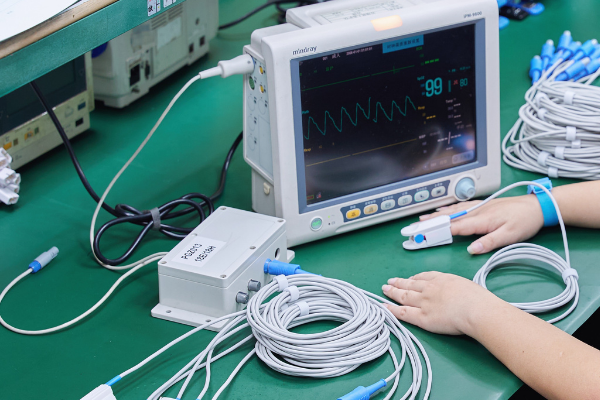A patient monitor is a device or system that measures and controls a patient’s physiological parameters, compares them with known setpoints, and issues an alarm if they are exceeded. The management category is Class II medical devices.
Fundamentals of Patient Monitors
Various physiological changes are sensed through sensors, and then the amplifier strengthens the information and converts it into electrical information. The data is calculated, analyzed and edited by data analysis software, and then displayed in each functional module on the display screen, or recorded as needed. Print it out.
When the monitored data exceeds the set target, the alarm system will be activated, sending out a signal to attract the attention of medical staff.
What scenarios are clinical applications in?
During surgery, after surgery, trauma care, coronary heart disease, critically ill patients, newborns, premature babies, hyperbaric oxygen chambers, delivery rooms, etc.

Classification of patient monitors
Single parameter monitor: Only one parameter can be monitored. Such as blood pressure monitors, blood oxygen saturation monitors, ECG monitors, etc.
Multi-function, multi-parameter integrated monitor: can monitor ECG, respiration, body temperature, blood pressure, blood oxygen, etc. at the same time.
Plug-in combination monitor: It is composed of discrete and detachable physiological parameter modules and a monitor host. Users can choose different plug-in modules according to their own requirements to form a monitor that suits their special requirements.
Test parameters for patient monitors
ECG: ECG is one of the most basic monitoring items of monitoring equipment. Its principle is that after the heart is stimulated by electricity, the excitation generates electrical signals, which are transmitted to the surface of the human body through various tissues. The probe detects the changed potential, which is amplified and then transmitted to the input. end.
This process is done through leads that are linked to the body. The leads contain shielded wires, which can prevent electromagnetic fields from interfering with weak ECG signals.
Heart rate: Heart rate measurement is based on the ECG waveform to determine the instantaneous heart rate and average heart rate.
The average resting heart rate of healthy adults is 75 beats per minute
The normal range is 60-100 beats/min.
Breathing: Mainly monitor the patient’s breathing rate.
When breathing calmly, neonatal 60-70 times/min, adults 12-18 times/min.
Non-invasive blood pressure: The non-invasive blood pressure monitoring adopts the Korotkoff sound detection method, and the brachial artery is blocked with an inflatable cuff. During the process of blocking the pressure drop, a series of sounds of different tones will appear. According to the tone and time, the systolic and diastolic blood pressure can be judged .
During monitoring, a microphone is used as a sensor. When the pressure of the cuff is higher than the systolic pressure, the blood vessel is compressed, the blood under the cuff stops flowing, and the microphone has no signal.
When the microphone detects the first Korotkoff sound, the corresponding pressure of the cuff is systolic pressure. Then the microphone re-measures the Korotkoff sound from the attenuated stage to the silent stage, and the corresponding pressure of the cuff is the diastolic pressure.
Body temperature: Body temperature reflects the result of the body’s metabolism and is one of the conditions for the body to carry out normal functional activities.
The temperature inside the body is called “core temperature” and reflects the condition of the head or torso.
Pulse: The pulse is a signal that changes periodically with the pulsation of the heart, and the volume of the arterial blood vessels also changes periodically. The signal change cycle of the photoelectric converter is the pulse.
The patient’s pulse is measured by a photoelectric probe clipped to the patient’s fingertip or pinna.
Blood gas: mainly refers to partial pressure of oxygen (PO2), partial pressure of carbon dioxide (PCO2) and blood oxygen saturation (SpO2).
PO2 is a measure of the oxygen content in the arterial blood vessels. PCO2 is a measure of the amount of carbon dioxide in the veins.
SpO2 is the ratio of oxygen content to oxygen capacity. The monitoring of blood oxygen saturation is also measured by photoelectric method, and the sensor and pulse measurement are the same. The normal range is 95% to 99%.
Post time: Apr-25-2022

